When putting together a training plan for yourself or an athlete, there are several considerations and steps. We take you through each of these and make the process easy.

As the 2021 calendar year is winding down, it’s time for most of us to plan our own and our athletes’ training programs for the upcoming year. This post primarily focuses on the coach/athlete relationship but the content is just as applicable to self-coached athletes. While there are many different ways to construct a training program, this post summarizes the 7 steps to create an annual running training program, as advised in our certification content.
So let’s get going! Below are some key areas to consider when developing a program, followed by steps to plan a successful 2022!
Factors to Consider When Creating an Annual Training Program
- Type of event (Single sport or multi-discipline)
- This will impact the number of sessions dedicated to one or more disciplines, cross-training, frequency of training, and days where you may be training twice (i.e., swim in the morning, run in the evening) to get the appropriate volume in
- Distance
- Location of event
- Local or travel, flat or hilly, altitude and environmental factors
- Hours to commit to on a weekly basis
- What is the minimum you need and maximum you can realistically dedicate to your training (and travel time for training, if needed)?
- Priority of where this fits in your life (i.e., work, family, other hobbies/interest)
- Financial constraints
- Race entry fees, equipment, nutrition/supplements, supplies, travel expenses
- Existing health issues or injuries
- Will anything need to be modified with your design approach because of this?
- Goals (first time event, time specific, multiple events in one season)
- Support and accountability system from training groups or partners, family members, online social media community of like-minded athletes
Tips for Developing Your Annual Calendar Plan
A training program must be dynamic and flexible with ongoing communication between the athlete and the coach to allow modifications as needed and progress to occur. The training program must be developed for the athlete and not for you, as well as constructed with the guiding principles of science and customization as the foundation.
Developing an annual calendar can seem daunting to a coach and even more overwhelming to an athlete to process and implement. By breaking it down into key sections you can be confident a structured plan is in place with the opportunity for success.
UESCA recommends that a training program be comprised of three components:
- Full “At a Glance” Program
- Weekly Training Programs
- Workout Database
By breaking down a training program into these three parts, you are able to view the program on multiple levels and thus, better able to understand the different elements of the program and how they interrelate.
Key Principles to Follow
1. Deconditioned athletes generally start at a low volume and intensity level and spend the majority of the training program focused on building fitness and endurance.
2. Higher conditioned and more experienced athletes will be able to focus less time on fitness and skill building and more time on increasing duration and intensity of training.
3. High volume/intensity training weeks will subsequently be followed by lower volume/intensity weeks.
4. As athletes progress through the training process, they should be able to handle a higher workloads.
5. Generally speaking, there should not be more than two consecutive weeks of increasing volume unless the training volume is low.
Rest and Recovery
The goal for any training program should be to stress the body and provide adequate rest so it can build up to become stronger and prepared to handle future stresses imposed upon it. Rest is vital as it is during that time the body is recovering on a cellular level and building back stronger.
Scheduling Easy and Hard Days
Recovery between workouts is important for many reasons. Some of these reasons are:
- Decrease the chance for injury/illness
- Make forward progress
- Get the most out of future workouts
- Reduce the chance for overtraining syndrome
Assessing an athlete’s need for recovery should be individually-based.
Sleep
We all know that sleep is vital in our recovery and readiness for optimal performance and from a physiological level impacts many key components for an athlete including glucose levels, blood pressure, and protein synthesis. Each athlete’s optimal sleep schedule and number of hours to aim for per night will differ and should also be used in the assessment and communication process to determine that person’s optimal target.
Program Development
This section details program creation and what an ideal training calendar may consist of. This should be an outline of what your program template will be and will be different for each athlete as well as the main event (‘A’ race) you are planning for and considering any other supplemental races used for training (‘B’ and ‘C’ races).
On the surface, creating a training program is a fairly straightforward and intuitive process. However, with so many variables, it is often difficult to know exactly where to start and how to progress the program. If you are a coach, you never know who will want your coaching services, you cannot afford to make any assumptions (i.e., currently running 15 miles/week) when creating a training program. While it is fine to use some form of template for your athletes, the template must be completely customizable to the needs of each athlete and make no assumptions.
Following is the step-by-step process by which UESCA recommends creating a training program. Each step is elaborated on later in the post.
Creating an effective training program is a dynamic process that is constantly changing. While it would be nice if the training program creation process would follow an easy, linear progression, the reality is that this process is full of zigs and zags and stops and starts and must take a near infinite number of variables into consideration.
While training program design products and services exist on the market that are more or less plug-and-play, you must realize and understand that if you can enter in just a few fields of information and can get a fully “customized” program, there is no way it can take all of the necessary variables into consideration. As a result, the program is likely lacking in one or more areas. The true value of quality coaches is that they should always have their eye on the athlete in respect to the training program and make any and all modifications to the program as needed.
Step 1: Time Availability
- Before you can start working with athletes, you need to know how often they can train and for how long. In order to progress, their training availability must be appropriate for the event type/distance they are training for.
- If a athlete’s goal and training availability are grossly mismatched, such as having three days/week (one hour per day) to train for a marathon, you must inform the person this will not work and select a more applicable goal (i.e., 5‒10K).
- Athletes have many obligations other than training, some of which come up unexpectedly. This is the norm, not the exception! It is your responsibility as the coach to develop a program that takes this into consideration.
Step 2: Initial Training Volume
- Once you know that an athlete’s training availability is appropriate for the type/distance event they are training for, you need to know if they are currently training and if so, what their longest run is. For this long run to have value in the creation of the training program, it must be recent, completed without injury, and have been progressively built up to.
- If an athlete is deconditioned and/or not currently running, you must be very careful to start them at a low level and progress the individual slowly to allow the body to adapt from a musculoskeletal standpoint. If an athlete has never run before and has poor running form, a large focus must be on proper running form/gait. The initial training volume for an athlete such as this would likely be a run/walk strategy, building up the length of the running component appropriately.
Step 3: Plot Goals
- At this point, you have two of the four pieces of information that you’ll need to determine if a goal event is feasible. If it is determined that it is not feasible, an athlete must either select a goal event that is more aligned with training load or not work with you. It is that simple.
- This is also the step where you will want to determine which, if any, tune-up races should be added to the program.
Step 4: Determining Long Runs
This step is what completes the feasibility aspect of the program. The two elements of this step that are the most important to be aware of are:
- Longest run- The longest run is used to benchmark an athlete’s preparedness in respect to a goal event. The reasoning behind this is simple ‒ having the ability to run at or near the full distance of the goal event is a prerequisite to being able to compete and finish a race/event feeling good and with the least chance for injury. The typical mileage range for the longest run is:
Half Marathon: 12–13 miles
Marathon: 18–22 miles
10K: 6–10 miles - Suggested long run training volume increases.
The longest run is used to benchmark an athlete’s preparedness in respect to a goal event. The reasoning behind this is simple ‒ having the ability to run at or near the full distance of the goal event is a prerequisite to being able to compete and finish a race/event feeling good and with the least chance for injury.
For marathons, peak mileage (long run) is typically attained twice during the program – once during the week before the first taper week and the other three weeks before the first taper week (there is typically a low-volume “long run” in the week between these two peak-mileage long runs).
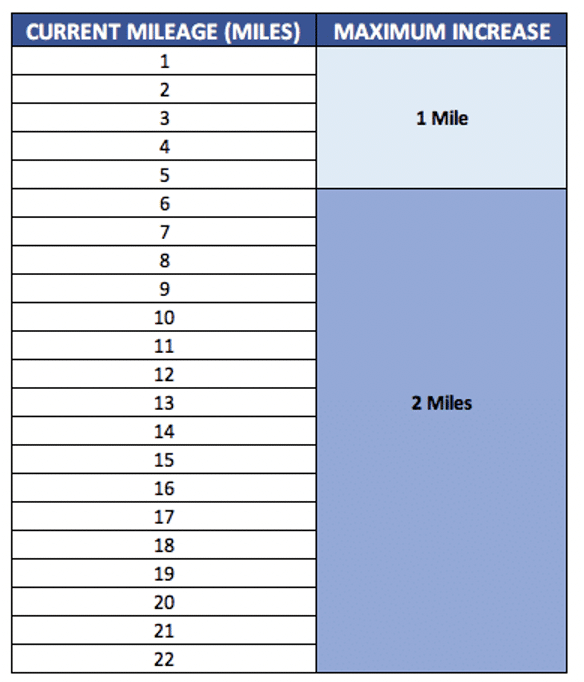
Step 5: Integrating Weekly Volume and Intensity Structure
This step is a guide for determining overall weekly volume increases and, more specifically, what the maximum overall weekly volume increases should be. This step is most effectively utilized by determining the maximum overall weekly volume and subtracting the long-run distance. The remainder of the distance represents the rest of the weekly run distances. The following chart roughly represents the maximum weekly volume increases. Therefore, overall weekly volume increases are likely to be less than what is noted in the chart.
NOTE: If your athlete is running less than five miles per week, the focus should be on learning proper form and musculoskeletal adaptation.
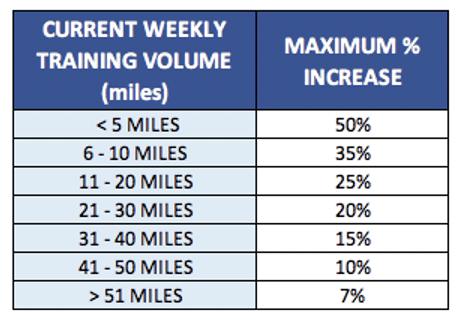
Step 6: Development of Daily and Weekly Information
Once the structure (duration, cycles, long-run volume, weekly volume) of a program is in place, the weekly training program can be developed. The weekly volume must match that of the previous step. If working with an athlete, weekly programs should be designed and sent weekly or biweekly. It is not advised to give your athlete more than two weeks’ worth of programming at a time to allow for feedback and changes in rate of progression, if necessary.
Following is a weekly template that denotes the following areas:
- Weekly date range
- Training theme/periodization phases (if applicable)
- Morning and evening workouts (if applicable)
- Distance (miles) or time duration of workout
- Pace range
- Total weekly volume
Below is an example of what a weekly training program could look like. There may be more or less data depending on what you feel is needed to adequately guide your athlete through the training process.
NOTE: There are also quite a few online training logs and paid coaching platforms such as TrainingPeaks, that are popular. As such, the below weekly program chart is solely to be used as an example.

Step 6A: Integrate Daily Workouts
Once the weekly template is established, daily workouts can be integrated.
Integration of Workout Type
Workout types within a training program are repetitious in nature. Therefore, it is suggested you create a database of workouts for your athletes. This way, each workout type can be thoroughly explained and the only variables that change are the intensity and volume. How you decide to define them is up to you. However, something simple and intuitive typically works best.
When creating a workout database, categorize exercises by activity. There can be as many workouts under each discipline as needed. For example, if you have six running workouts, they could be R1‒R6. By having a workout database, all your athlete needs to do is look at the referenced workout number to get the workout information and then refer to the weekly schedule for the volume (e.g., time and/or distance) and pace, if applicable.
Creation of a workout database is initially time-consuming, but it is a time saver throughout the training process. A database helps athletes, as more specific workout information can be provided for each exercise/workout. If you have an exercise or workout that does not fit into the database, note “custom” on the weekly workout sheet and specify the exercise/workout in an email or over the phone. If you think a workout/exercise might be repeated, add it to the database. The legend to the right lists examples of how you could denote your workouts for the sport disciplines:
Workout Designation
Following is a sample workout legend:
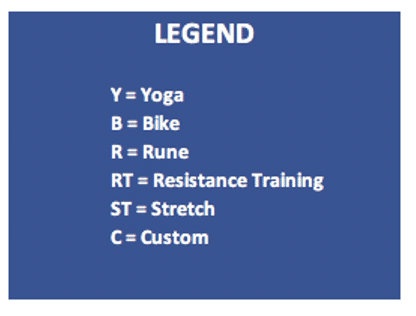
In this below example, the following areas are addressed:
- Workout type
- Rate of perceived exertion (RPE)
- Heart rate (HR) zone
- This can be expressed by other means, such as pace type (e.g., tempo)
- Description/Notes
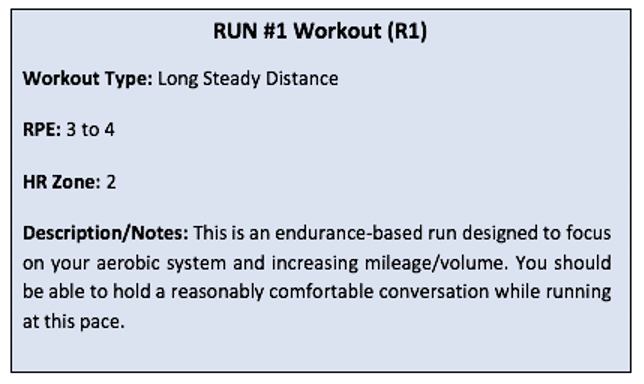
Integration of Daily Workouts into a Weekly Program
Referencing the workout database, integrate workouts into the weekly program.

When integrating daily workouts into the weekly program, you can include as many or as few training guidelines as you want. It is advised to be as detailed as possible so there is little to no interpretation required on the part of an athlete.
Weekly Distribution of Session Types
How many times per week should the following types of workouts be included in a weekly program?
- Repeats
- Easy runs
- Tempo
- Distance
This question cannot be answered as it is completely based on an individual and where the they are in the training program. It is advised to select the number of workout types per week based on the following considerations.
When determining the number of workout types (e.g., tempo, easy run) per week, it is helpful to begin with the total number of available workouts as well as how much time can be allocated for each specific workout. To determine this, go back to Step 1, Training Availability. Using this information, plot out a weekly schedule. Just because an athlete has a certain number of available days/times to train does not mean that the individual has to train during each available time slot. In fact, this is actually discouraged.
Athletes who are training for a running race purely for fitness and/or weight loss often participate in a variety of exercise types such as swimming, cycling, strength training, group fitness classes, etc. Avid runners also partake in these activities to enhance their running. It is encouraged to have your athlete participate in activities other than running. This helps to reduce the chance for mental burnout and injury and can enhance their performance via cross-training.
Step 7: Putting It All Together
Some athletes (and coaches) want to be able to see the whole program at a glance. While this format typically does not have much in the way of specifics, it can be modified to add more information. This is a fusion of steps 5 and 6.
Below is a mock-up of a hypothetical program based on steps 5 and 6. As noted previously, the workouts are noted by their designation (ex: R1). This way, the only other variable noted is the mileage.
NOTE: This hypothetical program does not have the athlete doing any other forms of cardio (i.e., cycling). A ‘real’ program will likely integrate other cardio forms, as well as other exercise modalities such as yoga, swimming, etc.…
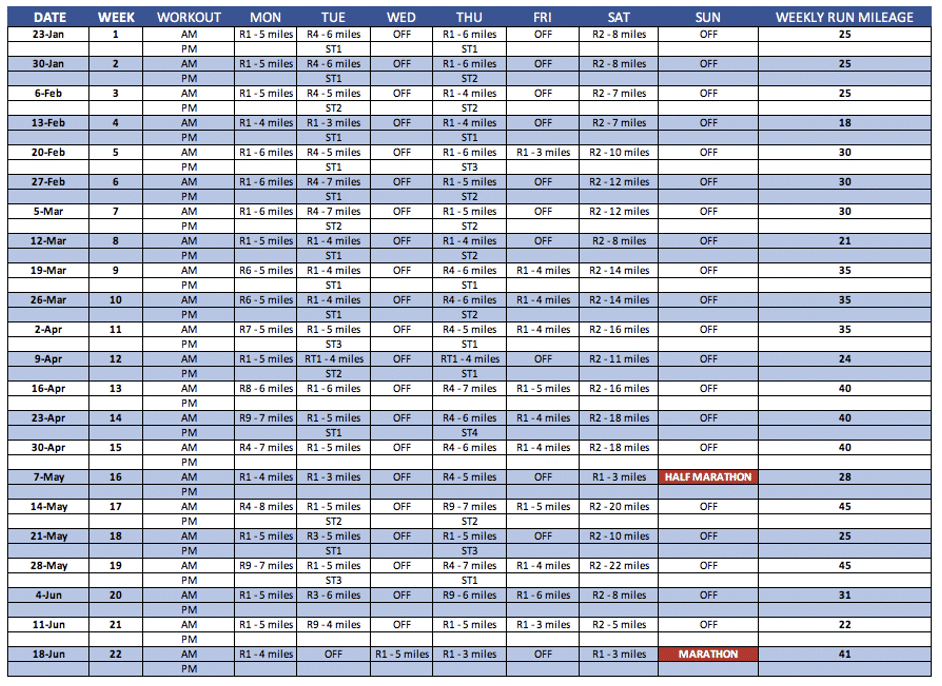
Summary
So there you have it – 7 steps to create an annual running training program! In closing, here are some key takeaways to remember when developing a running training program.
- Upon assessment (or reassessment) of an athlete, staying in constant communication with them is key and adjusting the program as needed based on compliance, feedback, and performance of the workouts.
- Each athletes’ optimal training load and frequency will be different. Thus, we stress that preformatted programs are not the best approach.
- The “more is better” principle when applying progression is not always the best strategy and must be considered with the athlete’s weekly performance, rest and recovery, and nutritional plan. Ensure that any type of progression makes sense based on an athlete’s current performance and compliance with their training program.
- Lastly, remember that program design in any sport is an “art and a science.” Being flexible and open to adjusting the program within reason to further increase an athlete’s success goes a long way!
_________________________________________________________________________
Sean Begley is a contributor and advisor to United Endurance Sports Coaching Academy (UESCA), a science-based endurance sports education company. UESCA educates and certifies running, ultrarunning and triathlon coaches (cycling coming soon!) worldwide on a 100% online platfom.








